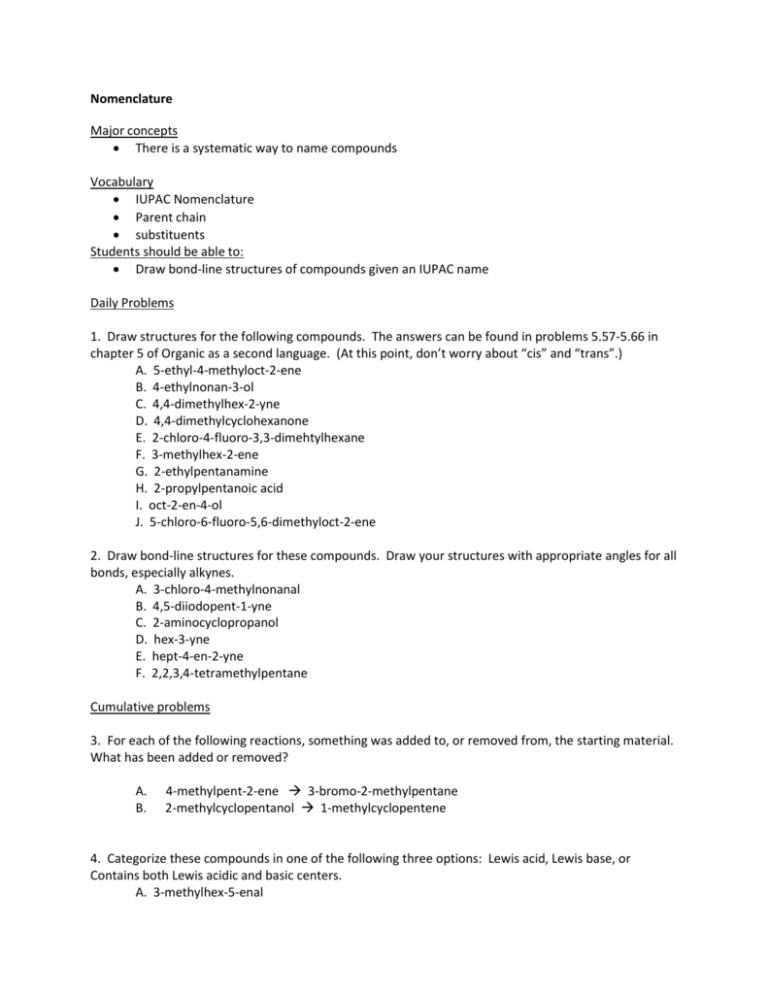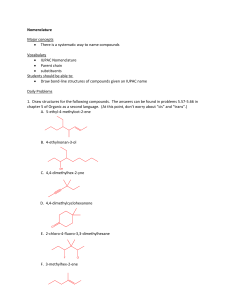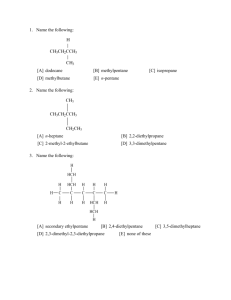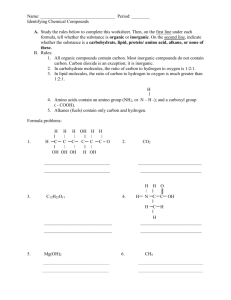Nomenclature Major concepts There is a systematic way to name
advertisement

Nomenclature Major concepts There is a systematic way to name compounds Vocabulary IUPAC Nomenclature Parent chain substituents Students should be able to: Draw bond-line structures of compounds given an IUPAC name Daily Problems 1. Draw structures for the following compounds. The answers can be found in problems 5.57-5.66 in chapter 5 of Organic as a second language. (At this point, don’t worry about “cis” and “trans”.) A. 5-ethyl-4-methyloct-2-ene B. 4-ethylnonan-3-ol C. 4,4-dimethylhex-2-yne D. 4,4-dimethylcyclohexanone E. 2-chloro-4-fluoro-3,3-dimehtylhexane F. 3-methylhex-2-ene G. 2-ethylpentanamine H. 2-propylpentanoic acid I. oct-2-en-4-ol J. 5-chloro-6-fluoro-5,6-dimethyloct-2-ene 2. Draw bond-line structures for these compounds. Draw your structures with appropriate angles for all bonds, especially alkynes. A. 3-chloro-4-methylnonanal B. 4,5-diiodopent-1-yne C. 2-aminocyclopropanol D. hex-3-yne E. hept-4-en-2-yne F. 2,2,3,4-tetramethylpentane Cumulative problems 3. For each of the following reactions, something was added to, or removed from, the starting material. What has been added or removed? A. B. 4-methylpent-2-ene 3-bromo-2-methylpentane 2-methylcyclopentanol 1-methylcyclopentene 4. Categorize these compounds in one of the following three options: Lewis acid, Lewis base, or Contains both Lewis acidic and basic centers. A. 3-methylhex-5-enal B. but-3-ynoic acid C. 3,3,4-triethylcyclooctanone D. cyclobutanamine E. pentane-1,3-diol F. hex-1-en-4-yne G. 3-aminoheptanoic acid H. 2-hydroxycyclopen-3-enone Extension problems 5. Some of these functional groups have too many hydrogen atoms, which give them a formal charge which is not zero. Indicate which functional groups have an extra hydrogen atom, and then draw a “+” sign beside them. When a functional group has an extra hydrogen atom, we say that it is “protonated.” We can then say that a functional group is “protonated”—for example, we may see a “protonated ketone” or a “protonated ether.” Name all the functional groups above, calling them “protonated” if necessary.








